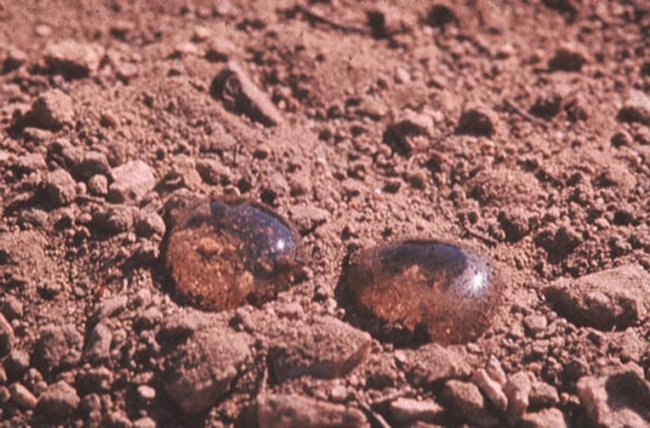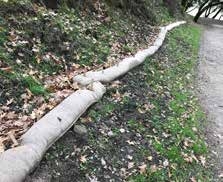I first heard the term hydrophobic soils on the local news after the Camp Fire ravaged the Ridge and Butte Creek Canyon. This potentially catastrophic natural phenomenon seems counterintuitive: soils which are damaged by the intense heat of fire become water repellent. Their post-fire inability to absorb and filter rainfall can cause immense problems with erosion and runoff. Adding insult to injury, fire also burns plant roots that can help stabilize the soil, and destroys plant stems and leaves that slow rainfall's contact with the ground surface, allowing more time for percolation into the soil.

According to an article by Douglas Kent (“First Aid for Sonoma County's Fire-Damaged Soil,” Santa Rosa Press Democrat, October 27, 2017), “erosion leaps as high as 200 percent following fires in urbanized areas.” The slopes and vales that comprise our foothill and mountain areas mean that the immediate danger from water repellent soil comes in the form of flash flooding and the flow of debris and mud. Hydrophobia in burn-scarred soils makes them as water repellant as pavement, and the National Weather Service notes that it takes much less rainfall to cause a flash flood in post-fire landscapes. Their rule of thumb is “if you can look uphill from where you are and see a burned area, you are at risk.”
Runoff caused by rainfall on water-shedding soils can also cause the loss of fertile topsoil. And it can clog water conveyance facilities including manmade culverts, gutters, and ditches, as well as streams and rivers. The upside of rainfall on soil hydrophobicity is that, generally speaking, water repellency weakens with each rain event.
The type of soil and the intensity of the fire determine how deeply hydrophobia penetrates the soil, and how long the condition persists. Paradoxically, the fastest draining soils (light, sandy soils with large pores) are the most prone to post-fire hydrophobicity because they transmit the heat more easily than heavy, dense, clay soils.

Prescriptions for large scale mitigation within burnt forested public lands, and large acreages of undeveloped private landholdings, are outside of the scope of this article. For the private landowner, the following steps outlined by Douglas Kent in his Press Democrat article can be taken to lessen and control the damage caused by the treacherous combination of heavy rain and burn-scarred soils. These procedures can be followed if the homeowner is 1) allowed back onto his / her property and 2) able to stay long enough to put these measures in place.
To hold your ground:
- Clear drainage systems such as culverts, diversion ditches, or narrow swales, of debris. Clogged drains are a primary cause of erosion, even without fire damage.
- Divert water from areas originally designed to sheet runoff to the landscape: instead, redirect the runoff towards your newly cleared drainage systems or, if they exist, towards storm drain systems such as gutters. Use sandbags, diversion ditches, boards stacked on top of one another and staked in place, dry stacked walls, or bales to redirect water flow.
- Minimize foot and equipment traffic on burned landscapes. Such traffic can further compact already damaged soils on flat areas, and can weaken soil bonds and dislodge soil particles on slopes. Develop plans to restore your injured landscape before tramping on it, and keep all traffic to the bare minimum during restoration activities.
- Leave non-toxic debris in place wherever possible. Burnt plant remnants and other garden features can protect the landscape from wind and water erosion, and help protect any seeds and plants that survived the fire.
You may not want (or be able) to return to your property within the perimeter of the Bear Fire / North Complex Fire. On behalf of the Butte County Master Gardener Program, we hope this information will help you in the process of healing the scars on your land and those in your soul. If you don't, we hope you find peace and beauty wherever you choose to land and to landscape.
For more information on dealing with the effects of wildfire on soil, and landscaping with the possibility of fire in mind, see the Fire-Safe Landscape section of the UC Master Gardeners of Butte County website. Among other resources, see “The New Normal: Rebuilding Soil After Fire,” a PowerPoint presentation from the UC Master Gardeners of Sonoma County which covers how wildfires affect soil, soil regeneration, and strategies for dealing with toxic soil.
UC Master Gardeners of Butte County are part of the University of California Cooperative Extension (UCCE) system. To learn more about us and our upcoming events, and for help with gardening in our area, visit our website. If you have a gardening question or problem, email the Hotline at mgbutte@ucanr.edu (preferred) or call (530) 538-7201.